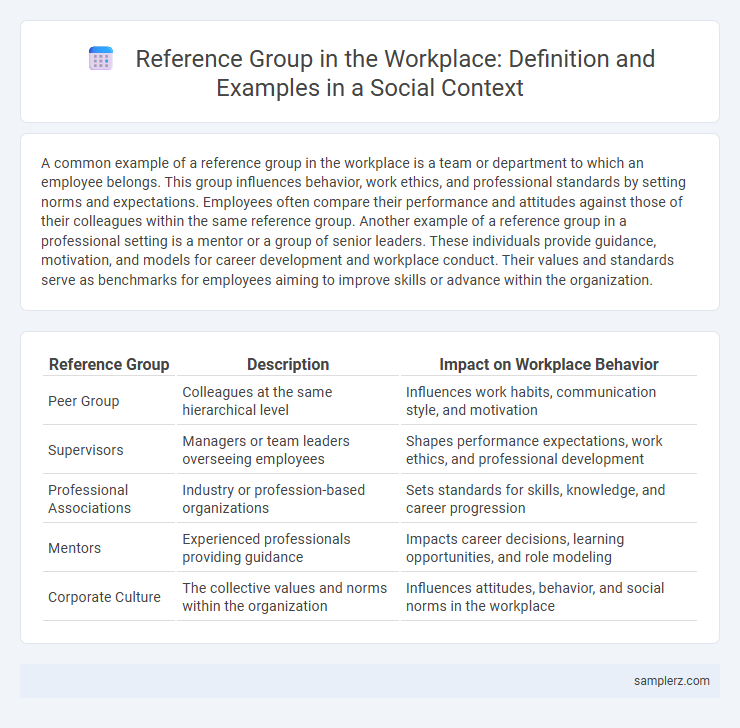A common example of a reference group in the workplace is a team or department to which an employee belongs. This group influences behavior, work ethics, and professional standards by setting norms and expectations. Employees often compare their performance and attitudes against those of their colleagues within the same reference group. Another example of a reference group in a professional setting is a mentor or a group of senior leaders. These individuals provide guidance, motivation, and models for career development and workplace conduct. Their values and standards serve as benchmarks for employees aiming to improve skills or advance within the organization.
Table of Comparison
| Reference Group | Description | Impact on Workplace Behavior |
|---|---|---|
| Peer Group | Colleagues at the same hierarchical level | Influences work habits, communication style, and motivation |
| Supervisors | Managers or team leaders overseeing employees | Shapes performance expectations, work ethics, and professional development |
| Professional Associations | Industry or profession-based organizations | Sets standards for skills, knowledge, and career progression |
| Mentors | Experienced professionals providing guidance | Impacts career decisions, learning opportunities, and role modeling |
| Corporate Culture | The collective values and norms within the organization | Influences attitudes, behavior, and social norms in the workplace |
Defining Reference Groups in the Workplace
Reference groups in the workplace are distinct social groups that employees use to evaluate their own behaviors and attitudes, such as professional teams, management circles, or industry networks. These groups influence workplace norms, career aspirations, and decision-making processes by providing standards for comparison and motivation. Understanding these reference groups helps organizations tailor leadership strategies and enhance employee engagement.
Types of Reference Groups Employees Encounter
Employees commonly encounter normative reference groups in the workplace, such as peer teams that influence daily behavior and work ethics. Comparative reference groups, like mentors or senior management, provide benchmarks for performance and career development. Aspirational reference groups, including industry leaders or professional associations, inspire employees to adopt desired skills and attitudes.
The Impact of Peer Groups on Professional Behavior
Peer groups in the workplace, such as teams or departments, significantly influence individual professional behavior by shaping norms and expectations around communication, productivity, and ethical standards. Employees often mirror the work habits and attitudes of their peer group, leading to conformity in performance and collaboration styles. This social influence fosters a cohesive environment that can enhance motivation, accountability, and overall organizational culture.
Role Models as Reference Groups in Corporate Settings
Role models in corporate settings serve as influential reference groups by exemplifying desired professional behaviors, work ethics, and leadership styles. Employees often emulate these individuals to enhance their skills, career progression, and organizational integration. Their impact extends to shaping workplace culture and driving employee motivation and performance.
Leadership Teams as Influential Reference Groups
Leadership teams serve as influential reference groups within the workplace by shaping organizational culture and setting performance standards. Their behaviors, values, and decision-making processes significantly impact employee attitudes, motivation, and collaboration. As role models, leadership teams guide workplace norms and influence individual and group behavior toward achieving company goals.
Cross-Departmental Reference Groups in Organizations
Cross-departmental reference groups in organizations include project teams comprising members from marketing, finance, and product development collaborating to set performance standards and influence work behaviors. These groups facilitate knowledge sharing and foster innovation by combining diverse expertise and perspectives, impacting organizational culture and employee motivation. Such reference groups often guide decision-making processes and help align individual goals with broader company objectives.
Informal Social Circles and Workplace Norms
Informal social circles in the workplace, such as lunchtime groups or hobby-based gatherings, serve as key reference groups that influence employee behavior and attitudes. These social networks shape workplace norms by fostering shared values, communication styles, and unwritten rules that guide daily interactions. Understanding these informal groups is essential for managing organizational culture and promoting collaboration.
Professional Associations as External Reference Groups
Professional associations serve as influential external reference groups in the workplace by setting industry standards and ethical guidelines that employees and organizations strive to meet. Membership in these associations offers access to specialized knowledge, networking opportunities, and credibility, which shape professional behavior and career development. These groups impact workplace culture by promoting shared values and fostering continuous learning aligned with sector-specific best practices.
Virtual Reference Groups in Remote Work Environments
Virtual reference groups in remote work environments often include online professional communities, collaborative project teams, and social media networks where employees exchange ideas, norms, and feedback. Platforms such as Slack, Microsoft Teams, and LinkedIn serve as critical hubs for these virtual reference groups, enabling real-time communication and knowledge sharing across geographically dispersed teams. These digital networks influence workplace behavior, motivation, and organizational culture by providing social support and reinforcing professional standards.
The Influence of Reference Groups on Employee Motivation
Reference groups in the workplace, such as peer teams, supervisors, and professional networks, significantly shape employee motivation by establishing behavioral norms and performance standards. When employees identify with high-performing groups, their commitment and productivity increase due to social comparison and the desire for acceptance. Organizations leveraging positive reference groups can enhance motivation by fostering collaborative environments and recognition systems aligned with group values.

example of reference group in workplace Infographic
 samplerz.com
samplerz.com